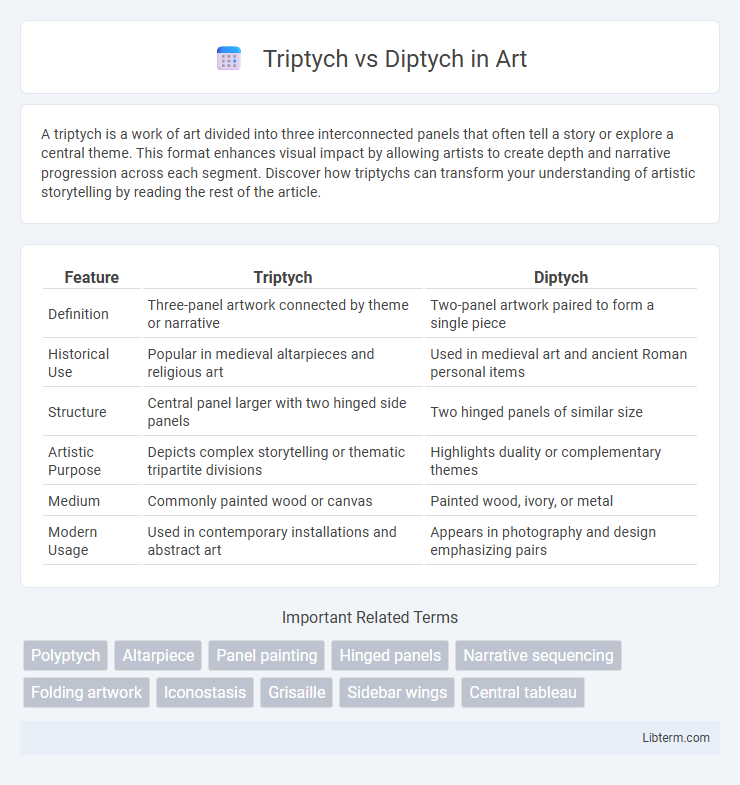A triptych is a work of art divided into three interconnected panels that often tell a story or explore a central theme. This format enhances visual impact by allowing artists to create depth and narrative progression across each segment. Discover how triptychs can transform your understanding of artistic storytelling by reading the rest of the article.
Table of Comparison
| Feature | Triptych | Diptych |
|---|---|---|
| Definition | Three-panel artwork connected by theme or narrative | Two-panel artwork paired to form a single piece |
| Historical Use | Popular in medieval altarpieces and religious art | Used in medieval art and ancient Roman personal items |
| Structure | Central panel larger with two hinged side panels | Two hinged panels of similar size |
| Artistic Purpose | Depicts complex storytelling or thematic tripartite divisions | Highlights duality or complementary themes |
| Medium | Commonly painted wood or canvas | Painted wood, ivory, or metal |
| Modern Usage | Used in contemporary installations and abstract art | Appears in photography and design emphasizing pairs |
Understanding Triptych and Diptych Artworks
Triptych and diptych are two types of multi-panel artworks commonly used in art history, with triptychs consisting of three panels and diptychs featuring two. Triptychs often present a central panel flanked by two related images, creating a narrative or thematic unity, while diptychs typically pair two complementary scenes or motifs side by side. Understanding these formats enhances the interpretation of the visual storytelling techniques used by artists to convey complex ideas or religious themes.
Historical Origins and Evolution
Triptychs and diptychs originated in early Christian art, with diptychs initially serving as portable hinged tablets for writing or painting in the Roman Empire during the 4th century. Triptychs evolved from this design in the Middle Ages, particularly between the 12th and 15th centuries, becoming popular for religious altarpieces with three panels symbolizing the Holy Trinity. Over time, triptychs expanded beyond ecclesiastical art into secular contexts, reflecting a broader narrative structure and visual storytelling format.
Core Differences: Triptych vs Diptych
Triptych and diptych differ primarily in the number of panels: a triptych consists of three connected panels, while a diptych has two. Triptychs are often used for more complex storytelling or thematic representation, providing a broader narrative scope. Diptychs typically focus on a duality or contrast between two related subjects, emphasizing simplicity and direct comparison.
Symbolism and Themes Explored
Triptychs often symbolize a narrative progression or divine hierarchy, with three panels representing past, present, and future or birth, life, and death. Diptychs emphasize duality and contrast, exploring themes such as life versus death, good versus evil, or human versus divine. Both formats deeply engage with spirituality and identity, using their structural divisions to enhance thematic complexity and symbolic meaning.
Popular Uses in Religious Art
Triptychs and diptychs are prominent in religious art, with triptychs often used as altarpieces in Christian churches, featuring a central panel flanked by two hinged side panels depicting biblical scenes or saints. Diptychs, composed of two panels, are commonly found as portable devotional objects or prayer aids, displaying complementary religious imagery or prayers. Both formats serve to enhance spiritual contemplation and narrative storytelling in liturgical settings.
Modern Interpretations and Applications
Modern interpretations of triptych and diptych formats extend beyond traditional religious themes, embracing contemporary art, photography, and digital media to explore fragmented narratives and multi-perspective storytelling. Artists utilize triptychs to create expansive visual dialogues across three panels, enriching thematic complexity and immersive experiences, while diptychs often emphasize contrast or complementary pairs, highlighting duality or transformation. These formats are widely applied in galleries, advertising, and virtual exhibitions to engage audiences through layered meanings and dynamic compositions.
Key Artists and Iconic Examples
Triptychs and diptychs serve as popular formats in art, with key artists like Hieronymus Bosch and Hans Memling pioneering triptychs, exemplified by Bosch's "The Garden of Earthly Delights." Diptychs find prominence in the works of Pablo Picasso, who utilized this two-panel format in pieces such as "The Honeymoon." Both formats offer unique narrative potentials, with triptychs often presenting a three-part story across panels and diptychs providing a dual perspective or complementary scenes.
Display Techniques and Presentation
Triptych and diptych display techniques differ in panel arrangement and visual storytelling. Triptychs use three panels, allowing a central image with complementary side panels, enhancing narrative depth and spatial balance. Diptychs consist of two panels, creating a direct contrast or dialogue, often emphasizing symmetry and focused thematic interplay in presentations.
Impact on Viewers and Storytelling
Triptychs create dynamic visual narratives by dividing a story into three interconnected panels, encouraging viewers to engage with the progression and relationships between scenes, which heightens emotional impact and complexity. Diptychs, with their two-panel structure, offer a more immediate juxtaposition or contrast, emphasizing duality or comparison that invites reflection and deeper interpretation. The choice between triptych and diptych formats significantly influences storytelling rhythm, viewer immersion, and the interpretive depth of visual art.
Choosing Between Triptych and Diptych for Your Art
Choosing between a triptych and diptych depends on the narrative complexity and spatial impact desired in your artwork. Triptychs offer a three-panel format ideal for developing detailed stories or thematic progression, while diptychs provide a simpler, two-panel presentation suited for contrasting ideas or complementary images. Consider the visual balance and viewer interaction to decide which format best enhances your artistic message.
Triptych Infographic

 libterm.com
libterm.com